THE CIRCLE WORKS – CELEBRATING 30 YEARS
Reflection

Our work is founded on a simple conceptual framework, a mental map that helps us locate ourselves and find our bearings. It is a minimal version of what is sometimes called the learning cycle. Imagine The Circle Line with just three stations: Experience, Reflection, and Outcome.
Experience is the stuff life throws at us all the time. It peaks and troughs, it bunches and stretches, but it is always there. As long as human beings draw breath, experience can be seen as an infinitely renewable resource, a deep and richly rewarding mine of useful material.
Reflection is more like a clearing in the woods: a space where we can pause and try to make sense of where we’ve come from and where we’re going. It’s a space for remembering, for sorting; for making connections, and for seeing possibilities.
The third station is called ‘Outcome’, because reflection is largely pointless unless it makes a difference out there in the world. Where we say ‘outcome’, some versions of the learning cycle use the word ‘action’, but that doesn’t take into account the enlightenment that comes from a slight shift in perception, or the transforming effect of a sudden surprising connection in the mind.
Adapted from our presentation at ‘The Space Between’, a day conference held to mark The Circle Works’ 20th birthday in 2005.
”Through talking, silence, and simply sharing my experiences, I am able to reflect upon some of the more difficult and challenging aspects of hospital ministry. This time at The Circle Works enables me to ‘recharge the batteries’ on a regular basis, and also to simply ‘be’, with no expectations or conditions; a safe, protected space so valuable for me; space ultimately for healing and growth’’.
A hospital chaplain

For our 25th birthday in 2010 we asked twenty five friends for images they thought represented something of The Circle Works. Robert Neden gave us the picture above, and on the following ‘Story’ page is a detail from a photograph by Nathalie Dürmüller.
The objects of the company are the advancement of education, and the preservation and protection of mental health … by the practice and study of the arts and reflective dialogue as methods of learning.
The Circle Works’ Charitable Objects, as defined by the Charity Commission
Story
 Tony Merry, a leading authority on the Person Centred Approach, was our first supervisor and a major influence. Soon after Tony’s death in 2004 Geoffrey wrote a piece about ‘Story’ for the Redbridge RE Bulletin, beginning with a quotation from Tony that refers to The Circle Works:
Tony Merry, a leading authority on the Person Centred Approach, was our first supervisor and a major influence. Soon after Tony’s death in 2004 Geoffrey wrote a piece about ‘Story’ for the Redbridge RE Bulletin, beginning with a quotation from Tony that refers to The Circle Works:
‘Of primary importance to this whole project,’ he said, ‘is that people engaged in the educational process, whether as consumers or providers, get a chance to tell their stories, and that these stories are listened to and taken into account.’
When he wrote about the importance of people being able to tell their stories, I don’t believe (Tony) was imagining them sitting around and spinning yarns, even though he would have enjoyed that as much as anyone. He meant something bigger, and yet more ordinary. The stories he meant were not tales told for entertainment, but the events and experiences, the ups and the downs, the hopes and fears, that make us who we are. He might even have said that in as far as they are shaped by their antecedents, their experiences, and the future they imagine for themselves, people are their stories. Whenever the question ‘What’s your story?’ is asked, the question ‘Who are you?’ is seldom far away.

April 1995 saw the first issue of The O!, a small journal in which members of The Circle Works’ community were invited to tell stories about work and life. Six quarterly issues were produced altogether, and were enjoyed by many.

”If you need someone to talk to you can come here and talk about things that you are worried about. There’s time to talk properly.”
A child working with Jeannette
From 1997 to 2012 The Circle Works enjoyed a close relationship with Antidote, the ‘campaign for emotional literacy’ inspired by Susie Orbach and led by James Park. In 2004 Geoffrey went to Manchester to speak at an Antidote conference entitled ‘Whole-school emotional literacy: how to make it happen’:
We talk a lot about ‘telling the story’. The story is happening whether we like it or not: but where is it brought to consciousness? Where is the story being told?
‘Narrative competence’ – the understanding that events have come from somewhere, that there are reasons for things to happen, that process matters – is vital both to individuals and to organisations. Schools, like all evolving communities, need places where they can constantly be telling their own story.
In primary schools there are various places where the community can come to know its mind in this way. At their best, assemblies can be one: other examples are senior management team meetings, staff meetings, the school council, and governors’ meetings. The classroom circle, properly conducted, is another storytelling space.
But the principal storyteller is the leader. When the leader sees it as part of her continuing role to be discerning, thinking about and articulating the story, the organisation and those within it can become authors of their experience, not victims: and the need to retrieve that sense of authorship is the main reason for creating reflective space.
Hospitality
”At The Circle Works you get really good biscuits. Not your bog standard job with ‘jam’ that will whip out a filling, or creme spelt with no ‘a’, but cookies with great chunks of chocolate and nuts. Or lovely chewy oaty things with raisins that make it very dangerous to be left alone with the biscuit tin. … I can still remember the day, over twenty years ago, when my Managing Director stood up in a staff meeting and announced that the company would no longer provide biscuits for staff tea breaks. You know where you are placed in your employer’s list of priorities when they take the biscuits away. But as someone who has seen countless faces light up when the lid comes off The Circle Works’ biscuit tin, I’ve also seen the power that small gestures of hospitality can have on pressured and tired workers”.
Fraser Dyer, priest and writer
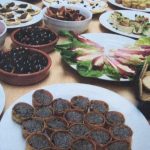
June 2013: the table laid for ‘A Waste of Good Paper’, an evening with Sean Taylor, poet, children’s writer and friend of The Circle Works.

Medway Buildings (1993-2002). Every autumn a new hop bine was hung on the chimney breast.
We became intrigued by the effect on visitors of the space we were providing. The result of our musings was a concept we called ‘hosted space’:
What defines hosted space is not just the presence of a host and a space, but the relationship between the two. The ‘person’ is not simply occupying the ‘place’ like a caretaker staying on the premises until it’s time to lock up, but inhabiting it expressively, responding to it and ordering it in ways that reflect something of themselves and their intentions. A hosted space is created mindfully, and to enter it is to encounter a mind. The mind that imbues a hosted space needs to be a ‘holding mind’, consistent and coherent as well as interesting, but it need not be the mind of an individual. Provided they communicate well enough to be ‘of a mind’ – which is not always as easy as it sounds –a pair of people or a group can certainly host a space together. In fact, the space is enhanced as the relationships between the hosts become woven into the hospitality they offer.
Here Canon Eric James writes about an experience as a member of the Archbishops’ Commission on Urban Priority Areas, set up in response to the plight of the inner cities in the early 1980s. As Director of Christian Action, Eric provided The Circle Works with its initial funding, and became its most generous benefactor. He died in 2012.
We were received by the first Muslim Mayor of Bradford. At lunch he suddenly asked me whether I would be willing to meet a group of Muslim teenagers that afternoon – all of them, he said, unemployed and angry. At half past two I met them. They hardly listened to a word I had to say: but I felt they were at least getting something off their chest. At four o’clock I looked at my watch – the Commission was meant to be getting a train back to London at about that time. “You’re not going,” said one of them angrily. “We’ve got a meal ready for you”. I hastily said, “If you want me to stay, of course I’ll stay.” Over that meal there was quite a different atmosphere. We became friends, I caught the last train back to London. They came and saw me off at the station. How often I’ve learned – but it’s a wisdom I’ve had to learn again and again – that meeting round a meal table is altogether different from merely “talking”.
Spirituality
Coming to Stillness
Meditation through Drawing
An invitation to creative quietness with The CircleWorks on the second Sunday of the month at The Royal Foundation of St Katharine, a peaceful, welcoming and calming space
A chance to be still, to relax, and to let your thoughts wander.
‘Coming to Stillness’, led by Heather with the artist Carol Baker, has been running since May 2010 and is the quiet heartbeat of The Circle Works.
For major creative projects we often turn for inspiration to Dr Jeffrey Higley, one of our trustees. In 2005 Jeff led a team in creating a Memory Garden in a local school. The photograph on the right was taken by Jeannette, and here, for an article in the journal of the Landscape and Arts Network, Jeff explains:
 ”You enter a little twisty passageway, and you come to what we call the Cloud Watching Seat. This enables you to recline and look up at the sky through a circular hole that’s been created in the foliage. All you have to do is cloud watch, and let your mind and your imagination range through that opening, which is like a round window on the sky. This is a place where just one or two people go to contemplate and think about the future: dream, imagine, focus, relax, and get into contact with stillness and what’s inside themselves”.
”You enter a little twisty passageway, and you come to what we call the Cloud Watching Seat. This enables you to recline and look up at the sky through a circular hole that’s been created in the foliage. All you have to do is cloud watch, and let your mind and your imagination range through that opening, which is like a round window on the sky. This is a place where just one or two people go to contemplate and think about the future: dream, imagine, focus, relax, and get into contact with stillness and what’s inside themselves”.

Jeannette Weaver in the Memory Garden
Anne Krisman is an award-winning teacher of Religious Education to children with general learning difficulties and more complex needs. In November 2008 The Circle Works invited Anne to speak about her work. Here is a moment from her talk, which she called ‘Setting the Angel Free’:

I remember when a 15 year old boy with speech and communication difficulties suddenly called out, “Is it true? Is it true that we’re born and then we die, is it true?” The class went very quiet and then each child took turns to comfort him, to say that, yes, it was true. The boy sat with his head in his hands, saying again and again, “That’s bad, that’s really bad.” Suddenly it felt that we had the Buddha in the class with us and we were present at his painful turning point in life, when he learnt the meaning of suffering. And this meant that our future work could never ever start from a low baseline.
“I saw the angel in the marble and I carved until I set him free.” Michelangelo
Relationship
‘To discover how to be human now
Is the reason we follow this star’
W H Auden: For the Time Being

Jeannette’s work with children 
At the heart of all our work is a resolute commitment to the primary importance of human relationship.
From The Circle Works’ welcome card

Thames walks, 2011 and 2012
In June 2004 The Circle Works was Guest of Honour at a tree planting in a school for pupils with learning difficulties. This is from our speech on that occasion:
In Southern Africa, people talk about ‘ubuntu’. They say of someone, ‘She has ubuntu. He has ubuntu.’ This is very high praise.
Ubuntu is a hard word to explain in English. It means having an open heart. It means sharing. It means belonging. It means knowing that I am connected with you. It means understanding that we are part of something bigger than ourselves.
Someone with ubuntu says, ‘My riches are your riches. My food is your food. When you hurt, I hurt. I am, because we are, and because we are, I am.’
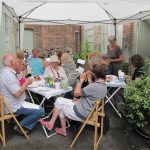
Temple Yard, July 2013: inside, a performance space; outside, a café. ‘Expect tea, cakes and songs both political and personal as Jenny Goodman and Sarah Harman combine their distinctive, delicious voices to become the Blameless Hussies… ’
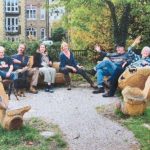
Its creators celebrate the completion of The Circle Works’ memorial to Jeannette Weaver, which stands in Mile End Park.
Creativity
 ”We sit round the table and we talk to each other and listen. Then we do really nice things like making masks or pop up books or make things with lolly sticks like we are today and while we are doing that we still talk to each other and we help each other and share things. I like it a lot. It’s the best thing I do, even better than pottery on Fridays. I dream about coming here – about what I will do.”
”We sit round the table and we talk to each other and listen. Then we do really nice things like making masks or pop up books or make things with lolly sticks like we are today and while we are doing that we still talk to each other and we help each other and share things. I like it a lot. It’s the best thing I do, even better than pottery on Fridays. I dream about coming here – about what I will do.”
A child working with Jeannette
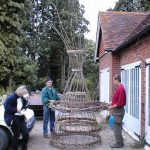
For Commonwork’s Millennium Open Day in 2000, The Circle Works chose the theme ‘Pause for Thought’. The result was the Wishcatcher, initially inspired by the Igbo tradition of the Ijele. It was 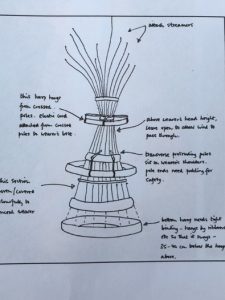 made by Jeff Higley, sculptor, and John Waller, green woodworker, and decorated by nearly four hundred children from Bangabandhu Primary School in Bethnal Green.
made by Jeff Higley, sculptor, and John Waller, green woodworker, and decorated by nearly four hundred children from Bangabandhu Primary School in Bethnal Green.
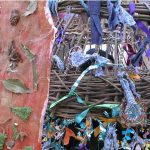
With Jeff inside it the Wishcatcher danced and swayed among the crowds , who were invited to tie on a ribbon and make a wish for themselves or for the world.
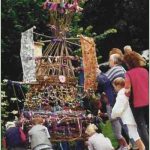

The ceremonial burning of the Wishcatcher took place on a dark November night.

All that remained was the hoop at Temple Yard.
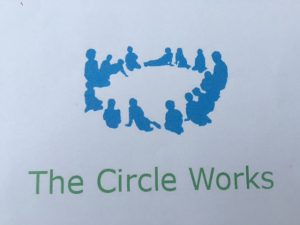
www.thecircleworks.org.uk
Honorary Director: Geoffrey Court Hon B.Ed
geoffrey@thecircleworks.org.uk
Registered Charity Number 1098873 The Circle Works Ltd: Company Number 4511392 Registered in England
